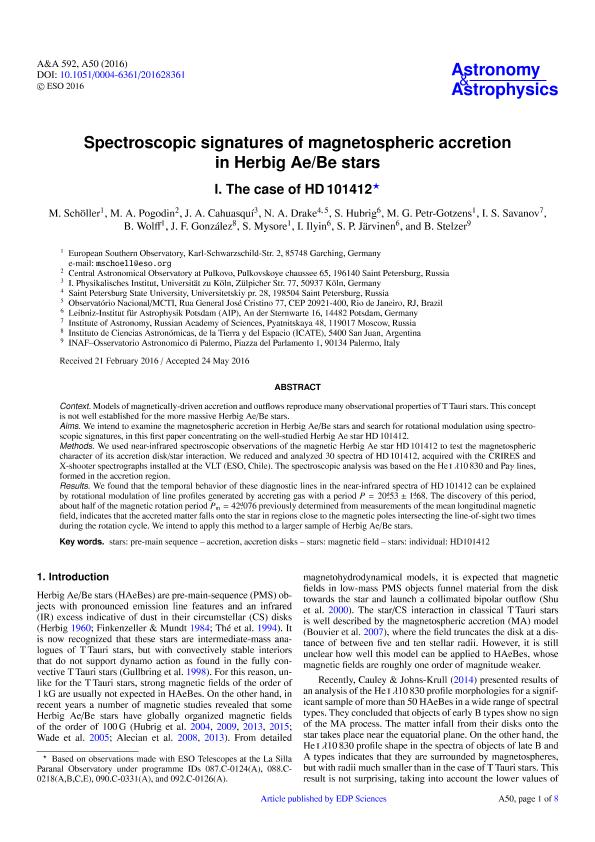Artículo
Spectroscopic signatures of magnetospheric accretion in Herbig Ae/Be stars: I. The case of HD 101412
Schöller, M.; Pogodin, M. A.; Cahuasquí, J. A.; Drake, N.A.; Hubrig, S.; Petr Gotzens, M. G.; Savanov, I.; Wolff, B.; Gonzalez, Jorge Federico ; Mysore, S.; Ilyin, I.; Järvinen, S.; Stelzer, B.
; Mysore, S.; Ilyin, I.; Järvinen, S.; Stelzer, B.
 ; Mysore, S.; Ilyin, I.; Järvinen, S.; Stelzer, B.
; Mysore, S.; Ilyin, I.; Järvinen, S.; Stelzer, B.
Fecha de publicación:
08/2016
Editorial:
EDP Sciences
Revista:
Astronomy and Astrophysics
ISSN:
0004-6361
Idioma:
Inglés
Tipo de recurso:
Artículo publicado
Clasificación temática:
Resumen
Context. Models of magnetically-driven accretion and outflows reproduce many observational properties of T Tauri stars. This concept is not well established for the more massive Herbig Ae/Be stars. Aims. We intend to examine the magnetospheric accretion in Herbig Ae/Be stars and search for rotational modulation using spectroscopic signatures, in this first paper concentrating on the well-studied Herbig Ae star HD 101412. Methods. We used near-infrared spectroscopic observations of the magnetic Herbig Ae star HD 101412 to test the magnetospheric character of its accretion disk/star interaction. We reduced and analyzed 30 spectra of HD 101412, acquired with the CRIRES and X-shooter spectrographs installed at the VLT (ESO, Chile). The spectroscopic analysis was based on the He iλ10 830 and Paγ lines, formed in the accretion region. Results. We found that the temporal behavior of these diagnostic lines in the near-infrared spectra of HD 101412 can be explained by rotational modulation of line profiles generated by accreting gas with a period P = 20d.53 ± 1d.68. The discovery of this period, about half of the magnetic rotation period Pm = 42d.076 previously determined from measurements of the mean longitudinal magnetic field, indicates that the accreted matter falls onto the star in regions close to the magnetic poles intersecting the line-of-sight two times during the rotation cycle. We intend to apply this method to a larger sample of Herbig Ae/Be stars.
Archivos asociados
Licencia
Identificadores
Colecciones
Articulos(ICATE)
Articulos de INST.D/CS ASTRONOMICAS D/LA TIERRA Y DEL ESPACIO
Articulos de INST.D/CS ASTRONOMICAS D/LA TIERRA Y DEL ESPACIO
Citación
Schöller, M.; Pogodin, M. A.; Cahuasquí, J. A.; Drake, N.A.; Hubrig, S.; et al.; Spectroscopic signatures of magnetospheric accretion in Herbig Ae/Be stars: I. The case of HD 101412; EDP Sciences; Astronomy and Astrophysics; 592; 8-2016; 1-8; A50
Compartir
Altmétricas



